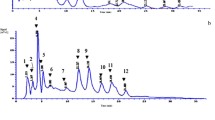Abstract
The growth-inhibitory activity of Thymus tosevii oil was evaluated using the agar diffusion method against 7 intestinal bacteria. The essential oil of T. tosevii exhibited potent growth-inhibitory activities against harmful intestinal bacteria. The growth-inhibitory activities of 5 oil components were evaluated against 7 intestinal bacteria to identify the active compound in T. tosevii oil. The growth-inhibitory activities of T. tosevii oil against harmful intestinal bacteria were attributed to myrtanol. Study of the structure-activity relationships between myrtanol structural analogues and antimicrobial activities revealed that (−)-cis-myrtanol, (+)-trans-myrtanol, and (−)-trans-myrtanol exhibited potent antimicrobial activities against harmful intestinal bacteria. Tetracycline was more active than the myrtanol analogues against intestinal bacteria as tetracycline inhibited growth of both beneficial and harmful intestinal bacteria. Some myrtanol analogues exerted selective growth inhibitory activities against harmful intestinal bacteria without adverse effects against beneficial intestinal bacteria.
Similar content being viewed by others
References
Tannock GW. Analysis of the intestinal microflora using molecular methods. Eur. J. Clin. Nutr. 56: 44–49 (2002)
Lee HS, Ahn YJ. Growth-inhibiting effects of Cinnamomum cassia bark-derived materials on human intestinal bacteria. J. Agr. Food Chem. 46: 8–12 (1998)
Rasic JL. The role of dairy foods contain Bifido and Acidophillus bacteria in nutrition and health. N. Eur. Dairy J. 48: 80–88 (1983)
Jeong EY, Jeon JH, Kim HW, Kim MG, Lee HS. Antimicrobial activity of leptospermone and its derivatives against human intestinal bacteria. Food Chem. 115: 1401–1404 (2009)
Phillips G, Tam C, Conti S, Rodrigues L, Brown D, Iturriza-Gomara M, Gray J, Lopman B. Community incidence of norovirus-associated infections intestinal disease in England: Improved estimates using viral load for norovirus diagnosis. Am. J. Epidemiol. 171: 1014–1022 (2010)
Kim HW, Lee CH, Lee HS. Antibacterial activities of persimmon roots-derived materials and 1,4-naphthoquinone’s derivatives against intestinal bacteria. Food Sci. Biotechnol. 18: 755–760 (2009)
Vagionas K, Ngassapa O, Runyoro D, Graikou K, Gortzi O, Chinou I. Chemical analysis of edible aromatic plants growing in Tanzania. Food Chem. 105: 1711–1717 (2007)
Jeong EY, Jeon JH, Lee CH, Lee HS. Antimicrobial activity of catechol isolated from Diospyros kaki Thunb. roots and its derivatives toward intestinal bacteria. Food Chem. 115: 1006–1010 (2009)
Yang JY, Cho, KS, Chung NH, Kim CH, Suh JW, Lee HS. Constituents of volatile compounds derived from Melaleuca alternifolia leaf oil and acaricidal toxicities against house dust mites. J. Korean Soc. Appl. Biol. Chem. 56: 91–94 (2013)
Lee HS. Tyrosinase inhibitor of Pulsatilla cernua root-derived materials. J. Agr. Food Chem. 50: 1400–1403 (2002)
Lim MY, Jeon JH, Jeong EY, Lee CH, Lee HS. Antibacterial activity of 5-hydroxy-1,4-naphthoquinone isolated from Caesalpinia sappan toward intestinal bacteria. Food Chem. 100: 1254–1258 (2007)
Kim MG, Lee HS. Growth-inhibiting activities of phenethyl isothiocyanate and its derivatives against intestinal bacteria. J. Food Sci. 74: M467–M471 (2009)
Sokoviæ MD, Vukojeviæ J, Marin PD, Brkiæ DD, Vajs V, van Griensven LJLD. Chemical composition of essential oils of Thymus and Mentha species and their antifungal activities. Molecules 14: 238–249 (2009)
Choi JH, Nam JO, Kim JY, Kim JM, Paik HD, Kim CH. Antioxidant, antimicrobial, and antitumor activities of partially purified substances from green tea seed. Food Sci. Biotechnol. 15: 672–676 (2006)
Kulevanova S, Stoeva T, Ristic M. The essential oil composition of Thymus tosevii and Thymus macedonicus from Bulgaria. Boll. Chim. Farm. 139: 85–88 (1999)
Yang JY, Lee HS. Acaricidal activities of the active component of Lycopus lucidus oil and its derivatives against house dust and stored food mites (Arachnida: Acari). Pest Manag. Sci. 68: 564–572 (2012)
Ahn YJ, Kim M, Kawamura T, Yamamoto T, Fujisawa T, Mistuoka T. Effects of Panax ginseng extract on growth responses of human intestinal bacteria and bacterial metabolism. J. Ginseng Res. 14: 253–264 (1990)
Amini M, Safaie N, Salmani MJ, Shams-Bakhsh M. Antifungal activity of three medicinal plant essential oils against some phytopathogenic fungal. Trakia. J. Sci. 10: 1–8 (2012)
Al-Fatimi M, Wurster M, Schroder G, Lindequist U. In vitro antimicrobial, cytotoxic and radical scavenging activities and chemical constituents of the endemic Thymus laevigatus (Vahl). Rec. Nat. Prod. 4: 49–63 (2010)
Author information
Authors and Affiliations
Corresponding author
Rights and permissions
About this article
Cite this article
Yang, JY., Lee, HW. & Lee, HS. Growth inhibitory activities of myrtanol and structural analogues from Thymus tosevii against intestinal bacteria. Food Sci Biotechnol 24, 169–174 (2015). https://doi.org/10.1007/s10068-015-0023-1
Received:
Revised:
Accepted:
Published:
Issue Date:
DOI: https://doi.org/10.1007/s10068-015-0023-1




